Tag: Cab Franc
You Never Forget Your First Crush
Scott Elliff of DuCard Vineyards once told me that harvest was a joyous time, the culmination of a year’s hard labor tending the vines. And on September 21, after four years of planning, preparation, and hard work, we experienced that joy in our own vineyard, picking grapes from the vines we had planted with our own hands and nurtured like our own children. If I’m at this ten years from now, I’m sure I’ll still find joy in the harvest, but I doubt that it will be anything like the euphoria I felt as we picked those first Cab Franc grapes this year.
To recap a bit, the Vineyard Goddess and I began this adventure some four years ago. We took classes on viticulture and enology at Piedmont Virginia Community College, did lots of research on our own, debated which clones and which rootstocks to order, and finally planted our vineyard in the (very) early spring of 2012. Since then, we’ve invested a lot of sweat, a couple of tears and even a little blood (I snipped my finger with the pruning snips during the harvest) in bringing those vines to the point where they were ready to produce a crop of grapes worthy of picking.
And, oh my God – did those vines ever produce!
The Cab Franc and the Petit Verdot were absolutely magnificent: nearly perfect fruit that proved irresistible to the bees that laid siege to those rows of vines. The Merlot, for whatever reason, fell behind. I had thought we’d pick the Merlot first among the reds, and by all rights we should have. But after accumulating sugar at a rapid pace, the Merlot vines just shut down. We picked them October 5, and I’m hoping for the best.
The Viognier was disappointing. Virginia-grown Viognier makes a wonderful wine, but it’s hard to grow. For some reason it’s subject to something called primary bud abortion, and I guess our vines experienced that phenomenon, because the Viognier was the least fruitful of all our varieties. The grapes looked lovely, but I had expected about 100 pounds or so, and we got about 20. Other vineyards around the Commonwealth had the same experience, though on a totally different scale (the difference between tons and tens of pounds).
The last of our varietals is Petit Manseng, and those grapes looked beautiful when we harvested them two weekends ago. We want to make a desert wine from them, and so we let them hang a bit longer than we might have. We had hoped they would accumulate a little more sugar and lose a little more acid. If we had known we were in for some pretty significant rain the week prior, we might have chosen differently, but weekend vintners like us have to make some tough decisions and then live with them. As it turned out, we didn’t get the extra sugar or the lower acidity. We’ll work with it.
But getting back to where I started, there are some things you never forget. I can still remember the first crushes of my life – the first time I saw the Vineyard Goddess in the newsroom of our college newspaper, the first book I really fell in love with (thank you, James Joyce), the first time I saw my children, and the first time I saw Venice, walking out from the train station on a beautiful sunlight day to see the Grand Canal sparkling with life. Some things you just never forget.
And so, I don’t want to get too sentimental about this, but when we had finished picking the Cab Franc on that beautiful September morning, the VG and I hugged and felt a sense of euphoria. All those years, all that sweat, and all that worry behind us; now we had the fruit of our labor in front of us, collected in a dozen five-gallon Home Depot buckets. It was one of the most wonderful moments of my life.
A little detail: we had gotten up at first light that morning to pick, and we finished before the sun hit the vines. The early morning, especially this time of the year, is cool, and you want the grapes to hit the crush pad (i.e., our driveway in Fairfax) cool. The crush, by the way, is the term applied to the harvest and the process of preparing the grapes for fermentation.
As we picked, we stored buckets in a refrigerator we had purchased just for this task. With the shelves removed, we could fit six buckets, stacked on top of each other, separated by the shelves I had pulled out and repurposed. As we brought more grapes up from the vineyard, we pulled the buckets from the frig and dumped them into a 120 quart cooler from Costco. When it was filled, we pulled out smaller coolers. The grapes were cool to the touch right up to the crush, and the must came in at around 60 degrees or lower.
As it turned out, picking the grapes was the easy part. I had done a lot of research and reading, a lot of planning, and a lot of online shopping for the equipment and supplies we would need. But for all that work, when it got down to actually making the wine, I found myself in the weeks before the harvest feeling a bit lost.
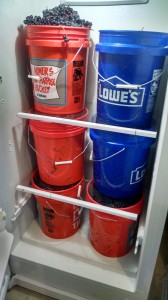
A refrigerator full of wine grapes — this is about half the load of Cab Franc. We dumped these into the cooler and refilled the frig.
So, before we picked the first grapes, I started making a cheat sheet. It went something like this:
First, add sulphur at a rate of 50 parts per million (.33 grams per gallon), which kills off unwanted natural yeasts and protects the must (the mix of juice, skins, seeds, and stems that will turn into wine) during those vulnerable hours before fermentation begins. Next, check the brix, pH and TA (titratable acidity) of the must (add a dozen steps here). Rehydrate the yeast (add a half-dozen steps here). And so on. (Add dozens and dozens of individual steps.) And for all that, I found myself furiously reading the instructions (again) on my lab test equipment to be sure I knew how to test the TA, and reading other literature on hydrating and preparing yeast.
When we arrived back in Fairfax, we started with the easy stuff: the sorting table. We had purchased a folding table, which turned out to be the perfect place for the family and friends to gather around for some work and talk. Kind of like what I imagine a quilting bee was like a century or so ago. We pulled some chairs around the table, and the VG and I, plus daughter Kate and a couple of neighbors, sorted the grapes. That’s easy and straightforward, but it’s also very time consuming.
The fruit was amazing, so we didn’t throw away very much at all. Mostly, we were looking for MOG – matter other than grapes. We found the occasional spider web (with the spider, in most cases, which elicited a few screams), and some extra leaves and such. But the fruit that went into the crusher was just about perfect.
The crusher-destemmer was way more of a machine than we really needed. It crushed the fruit faster than we could drop it in, and we were finished with that part of the process in maybe ten minutes. Honestly, cleaning it took way longer than the actual crushing. But I’m still glad I bought it. More on that in another post.
In the end, the Cab Franc yielded some 20 gallons of must – juice, grape skins, seeds and some stems that fell through the destemmer. As luck would have it, I had a 20 gallon bucket on hand to catch it all. Again, we’re still on the easy part.
I weighed the sulphur (potassium metabisulphite), mixed it with distilled water and added it to the must. And then, I spent hours measuring the pH and TA and brix, deciding whether to adjust the sugar level or acidity (I decided not to), and preparing to pitch the yeast. And in between, I cleaned out the crusher, the extra buckets, and everything else I used in the process. Not to mention sanitizing everything that came into contact with the must.
I have always used potassium metabisulphite for sanitizing, but now, with my own grapes at stake, I worried a bit. I had used sulphites at 50 ppm to protect the must, and the mix for the sanitizing solution was much stronger than 50ppm. So I decided to go with Star San, an acid-based sanitizer that requires no rinsing afterward. Pretty much every bone in my body was calling for sulphur, but I resisted.
It was some day. We were in the vineyard at about 7 a.m., and it was close to 10 before I pitched the yeast, which started the fermentation (Not right away mind you; no, the yeast played with me, waiting days before they actually began to ferment the must).
Much of the time spent that day involved nothing more than anxiety – wanting to get everything just right and worrying that I was getting everything just wrong – but another part of it was the actual physical labor involved. By the time the day was over, I was exhausted, and the memory of hugging the Vineyard Goddess at the end of the harvest was just that – a distant memory.
Well, I suppose in the end, it’s like dating the first girl you had a crush on – the hopes, the anxiety, the desire to get everything just right, the certainty that you have gotten everything totally wrong, and the physical exhaustion that comes from working so hard.
But I’m hoping this crush is like the time I laid eyes on the Vineyard Goddess for the first time. If this crush is as perfect as that one, we’ll have a wine for the ages.
Saving Our Grapes from Birds and Other Predators
Last year, as we approached harvest time, I was admiring our grapes one weekend day when I realized it was time to check the sugar levels. Unfortunately, I had left my refractometer in Fairfax, which, well, wasn’t very helpful. But not to worry. I made a mental note to bring it with me to Afton the following weekend, when I was sure that the sugar in the grapes would be just about perfect.
I remembered the refractometer, but unfortunately, I could not find the grapes. I searched the Petit Verdot rows, where I was sure I had seen small clusters hanging, and the Cab Franc rows, which I knew also had grapes hanging from the vines. But there were none to be seen.
It was kind of like the time my car was stolen at the train station in Jersey. I stared at the space where my car used to be wondering why it was no longer there, and then wandered around the parking lot as though I hoped it was magically somewhere else. Somewhere other than where I knew I had left it. Self-delusion is a terrible thing.
My car was gone, all those years ago, and last year, so were my grapes. My first thought was birds. Yeah, they love grapes, and they know when they’re ripe. They descend upon the vineyard just at the time when the brix (a measure of the sugar level) is just right, and they steal everything in sight.
Of course, it could have been other predators. It seems that all of nature has its eyes on grapevines as the harvest season grows near, and so the vineyard manager needs to be alert. Raccoons love grapes, as do squirrels and bears and crows and turkeys. As it happened, our neighbors told us about a bear they had spotted wandering through our property last year, right around the time we found a huge gash in our deer fence. Jim Parkhurst of Virginia Tech told the summer technical meeting of the Virginia Vineyards Association that a bear will sit down in the vineyard, pull clusters of grapes off the vine, and then move down the row, sit again and pull off more clusters.
But, of course, it’s hard to know for sure which predator stole my grapes. Last year was a very difficult year because of the acorn shortage. There are two types of acorns; those that come in every other year and those that come in annually. In 2013, both types failed. So squirrels especially were desperate for a meal, and vineyards were like the free sample aisle at Costco. I talked to vineyard managers who reported losing more than a third of their grapes to predators last year, which is extraordinary.
So, this year, we’re all taking precautions.
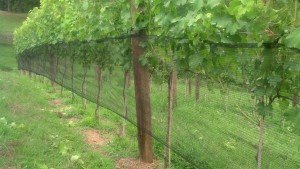
This is more or less what the netting will look like once it’s dropped. Here’, I’ve just attached it to the first catch wire on the Viognier vines, and haven’t yet rolled it up.
I spent the day Sunday (after a full day Saturday working with the Vineyard Goddess on canopy management) installing bird netting. Bird netting places a barrier between the grapes and predators, and hopefully it will be enough to preserve this year’s crop. I got about half-way through the vineyard, hanging the netting on my Viognier and Petit Verdot, and then rolling it up so that it will be out of the way until it’s needed.
I should point out that I would have also gotten the netting up on my Petit Manseng except that the Vineyard Goddess had found – I can’t even bring myself to say this – a bird nest in those rows, and asked me to wait a week or two. I wanted to rip the nest out, but I couldn’t. She’s the Vineyard Goddess, after all, and she outranks me when we’re working among with the vines.
As it turned out, I wouldn’t have gotten that far anyhow. I ran out of clips before I was quite through the Merlot, and I ran out of energy before I got to the Cab Franc. So, I ordered more clips today from Spec Trellising, and I’ll be praying next weekend that I don’t run out of netting. The roll that they shipped is 1,650 feet long, which should give me a couple of feet to spare. But who knows.
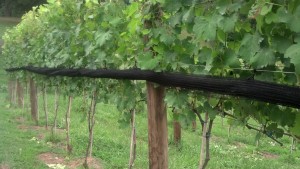
Here’s what the netting looks like after it’s rolled up, waiting until the grapes are ripe enough to attract predators.
A couple of words of advice to the weekend vintner about installing bird netting. First, don’t expect instructions. Apparently the netting doesn’t come with any. And don’t expect advice on how to install it – I didn’t get much. Also, don’t think the Internet will be of any help. I googled side-netting, bird-betting and every conceivable permutation of those terms for hours and got no help whatsoever. I did find lots of helpful advice, videos included, on different kinds of netting, especially the stuff that hangs over the trellis, creating a ceiling of sorts that you can drive a tractor underneath. But nothing for my side netting.
As it turned out, though, much to my surprise, bird netting isn’t all that hard to install.
Once I got the netting into the vineyard, and looked at the net clips, I was able to figure out (after one false start) how to do it. The clips look like tiny boat anchors, with a hook at the top to hold it to a catch wire and one hook on each side at the bottom. What I finally realized is that the back hook holds the netting on the catch wire permanently, and the front hook holds the rolled up netting (the storage position) until it’s ready for use.
I have lots of other questions, but I’ll figure it out as I go. And I ordered one more piece of equipment – small “C” hooks, which will hold the netting together at both the top and bottom to keep birds from finding a way in. I also have a tagging gun which is supposed to be a good way to zip shut the net at the bottom, but truthfully, I couldn’t figure out how to make the gun work this weekend.
I’m feeling pretty good about the netting, though. Unlike last year, I think most of my grapes will make it through to harvest. And if they don’t, it will be for reasons other than birds and other predators.
And, this is my first real harvest. As upsetting as it was to see my grapes stolen by predators last year, the fact is, it wasn’t that much of a loss. We had dropped fruit during the year to give the two-year old vines a good start in life. We wanted their energy to go toward developing a strong trunk and root system, not grapes. So, for those of you wondering exactly how many grapes were stolen, the answer is something like a half-dozen or so clusters that we missed when dropping fruit.
Not the end of the world, thank God. More like a cheap lesson for the future.
Where Did the Grapes Go?
Five days ago, at the end of the holiday weekend, I was thrilled with the progress of our vines. We hadn’t allowed a lot of grapes to accumulate, given that the vines were only in their second year, but we had left a few clusters, and they looked beautiful. Moreover, they tasted amazingly sweet.
Alas, last weekend I had left my refractometer at the other house, and so I couldn’t measure the Brix, which would have told me how much sugar had accumulated in the grapes and therefore the potential alcohol. Not essential, given that we weren’t planning to make wine from this grapes, but it would have been nice to know. But I told myself, it’s Monday, I’ll be back on Friday, and I’ll be able to measure the Brix on Saturday morning. What could go wrong with that?
Well, of course, lots of things could go wrong. But what I wasn’t expecting when I returned this weekend was to find the grapes gone. Yes, gone. As in, missing. As in, virtually none of them left on the vine.
It turns out I was right about one thing. The grapes had ripened and accumulated a decent amount of sugar. Which meant that they were not only close to being ready for the crush, they had become attractive to lots of the critters that roam through the country near our vineyard. Birds, deer, badgers – who knows? Almost any animal cruising near our property could have decided to chow down on our grapes.
So, a few lessons.
First, we didn’t lose quite all the grapes. I had put bird netting up around some of the Cab Franc vines a few weeks before, and those grapes were largely intact. I measured the Brix and it came in at about 21.2 percent. Not bad. Not quite ready for the crush pad, but getting there. It’s been a horrible year with the rain and dark skies, but another week or two in the sun (assuming we get a week or two of sun) and they might have made pretty decent wine.
Second, among the grapes we didn’t lose were those in the “mother vineyard.” These are the Cab Franc vines we had planted in the first year before we even knew where the main vineyard would be located. We had purchased them for practice and never even really considered that we’d use them for wine. These, the critters left alone.
But why? Well, when I measured the Brix it was at about 16 percent. Not even remotely ripe enough for wine. So maybe these grapes were ignored because they weren’t sweet enough. Apparently the critters that hang around our property are pretty choosy in what they bite off. Continue Reading–>
Looking Back on the First Year
So, now that we’ve been through most of a full season, from preparing the ground and putting in the trellis, to planting and nurturing the vines all the way through the “harvest” (three clusters that grew despite our efforts to keep the vines free of fruit), I think it’s time to enjoy a glass of someone else’s wine, reminisce happily about how well everything turned out, and then get down to the serious business of evaluating what we did right and what we did wrong. On the plus side, I think we got a lot of things right. We spent more time than I care to remember researching and thinking through what varietals we would plant and more specifically, what clones would do best on our property – 740-feet above sea level, on a steep, westward facing slope in Afton. We settled on four grapes – Cab Franc, Petit Verdot, Viognier and Petit Manseng – and I’m very happy with the choices we made. We’re thinking of putting in some Merlot next spring, but I think the four we started with are great grapes for Virginia.
- My job was to dig the holes. . .
- In a more or less straight line.
- And my wife, the Vineyard Goddess, did most of the planting.
We decided to go with ENTAV clones, and worked through three different nurseries to get the vines we wanted. For the record, we ended up getting ENTAV 214 Cab Franc; ENTAV 573 Petit Manseng; ENTAV 400 Petit Verdot; and ENAV 642 Viognier. We put all of them on 101-14 rootstock. Continue Reading–>
Pruning and training first-year vines
First-Year Vines Need Lots of Care
I’m still in the process of recovering from surgery and so unable to travel or tend a vineyard, but it turns out the vines are growing perfectly well without me. Who knew?
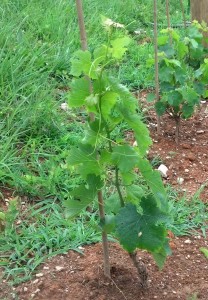
Here’s what one of the Cab Franc vines looked like before it was pruned and tied. You can see the tendrils caught the training stake and are holding it straight.
Still, young vines still need lots of care. In my absence, Chris, the Vineyard Goddess, and daughter Kate were on site in Afton last weekend to prune the vines, tie shoots to the training stakes and handle other assorted chores (mowing and spraying, among them), and once again they provided pictures and a full report from the front.
Tying the shoot to the training stake is an essential part of the vine’s development, and it turns out that there’s more than one approach to pruning and training first-year vines. Tony Wolf’s Wine Grape Production Guide for Eastern North America, for example, suggests leaving two or three shoots on the young vine, so that you’ll have something left if deer or other predators find their way into the vineyard and begin chowing down, or if one or more shoots simply break.
Wes Hagen, Clos Pepe’s vineyard manager and a regular columnist for WineMaker magazine, suggests a different approach. Choose the best of the shoots, tie it to the training stake and then – once you are certain that the shoot you’ve chosen is safely on the stake – prune away the remaining shoots and any swelling buds. We went with this approach, and hopefully we’ll finish the season with strong and relatively straight trunks to support the vines in the years to come.
You can see the results in the photos.
I remain hopeful that in another week or so I’ll be able to see the new vines for myself, but for now, it’s nice to know that they’re independent enough to carry on without me. And also nice to know that Kate is able to handle the mowing activities. Believe me, handling a lawnmower on a 15-20 degree slope is no picnic, and I won’t be in a position to use the tractor for a number of months. (Driving a tractor across the slopes is no picnic either; the pucker factor is always present!)
All of the nearby pictures were taken before she mowed, so the vineyard is looking a bit ragged in these shots. The rows themselves are pretty clean (with the possible exception of the Mammolos), although in some pictures, the camera angle makes it look otherwise.
By the way, keeping the rows clean can be a challenge. We decided not to use grow tubes to protect the vines, so spraying in the row with Roundup or another herbicide is more difficult and probably out of the question. However, our vineyard is small enough that we’re hoping to keep the rows clean by hand. (We’ll be getting out the hoe next visit — and probably the kneepads too, since at some point we’ll undoubtedly be down at ground level pulling weeds by hand!)
Spring in the Vineyard
Cab Franc vines, still protected by mounds of dirt, showing exuberant growth before being un-hilled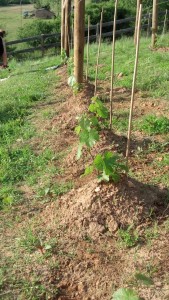
Despite months of crazy weather, it's finally springtime in the vineyard. And after all the hours of planning and research and all the work that went into getting the vineyard ready for planting vines – not to mention the planting itself – I was pretty bummed about not getting to see the early fruits of our labor this weekend. My wife, Chris, ably assisted by daughter Kate, the vineyard volunteer worker, traveled to Afton without me this weekend to un-hill new vines, continue the work on the deer fence, and handle a dozen other tasks that demand attention in the spring.
So, this isn’t exactly an eyes-on report from the scene. It’s more like something cobbled together by an editor hunkered down in a newsroom, piecing together a story out of dispatches sent in by reporters from the front lines. I've been both a reporter and an editor in my life, and believe me, being a reporter is way more fun. Editors sit behind desks in newsrooms waiting for reporters to tell them what’s going on. When I was an editor, I generally got cranky while waiting. Reporters get out of the office and see things happen. Even in the day of Blackberries and instant communication, I'm sure they still keep editors at bay during the day by telling them there’s way too much going on to stop and talk. And they’re usually right.
Petit Verdot vines after removal of the earth mounds, or hills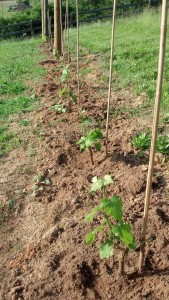
In this case, Chris and Kate filed their dispatches by text messages, emailed pictures, and a number of old-fashioned cell-phone calls, all of which provided some color on the early progress our vines are making. I have to say, we’re just thrilled with the results. Out of the 150 vines we planted this spring, only one appears to be clearly dead, according to the reports I've received, although another ten are doubtful. But the rest look magnificent! (Especially in the pictures.)
I’m particularly pleased with the progress of the first group of Cabernet Franc vines that we transplanted from our Fairfax vineyard two weeks ago. They not only survived, but they’re flourishing. And they have fruit! Big clusters of berries that will turn into grapes very soon if we leave them on the vine. Which, of course, we won’t. Even if the vines hadn’t been through the shock of being dug up in Fairfax and replanted in Afton, they’re still only in their second year of life, and they needto devote all of their energy to developing a strong root system and trunk. So we’ll be dropping the fruit soon.
Clusters of berries that would eventually be Cab Franc wine grapes if we let them continue to mature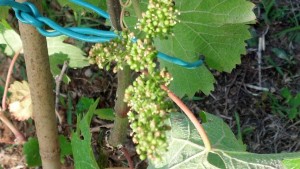
We had planted seven Cab Franc vines in Fairfax a year ago, all for the purpose of getting additional hands-on experience working with vines. This weekend, Chris dug up the last three and moved them, so the Fairfax “vineyard” is officially defunct, although it lives on in spirit in Nelson County. We can’t be sure that all seven will make it, but we’re very hopeful.
Cab Franc vines still in transplant shock from being moved on May 19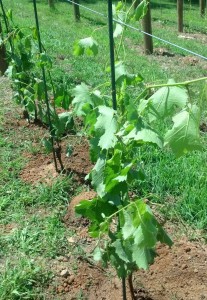
In any event, I'm glad we tried this experiment, which was prompted by an article by WineMaker’s magazine’s Wes Hagen. He recommended ordering extra vines and planting the excess closely together on some spare land. That way, you have some surplus vines to replace the ones that inevitably will die. And that’s one of the sad facts of viticulture. No matter how good you are, no matter how carefully you plant, and no matter how great the nursery you buy from, you’re going to lose some plants. So, even though some of the 50 Cab Franc vines that we planted this year will surely die, with the additional one-year old vines Fairfax we should end up ahead of the game. Wish I had read the Wes Hagen advice before we ordered vines for planting this year.
Looking at the rest of the vinyeard, our whites are doing quite well. We planted 25 each of Petit Manseng and Viognier on the weekend of March 31, and mounded hills of earth over them, covering the graft union with about two inches of soil to protect the dormant vines from the possibility of late frost. We un-hilled them two weekends ago on May 6, and they have been doing quite well ever since.
Close up of a Petit Manseng vine that was planted April 21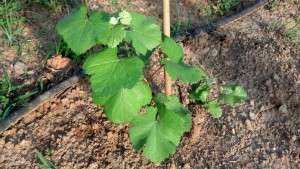
Likewise, the reds are showing great promise. Chris and Kate un-hilled the 100 Cab Franc and Petit Verdot vines that we planted over three days in early April. Both grapes seem to do well in Virginia, and we are wildly optimistic about their potential. Which, of course, puts us in the company of farmers everywhere who start each spring full of optimism, no matter how bad the previous year went. And don’t get anyone started talking about the 2011 vintage. Trust me, just don’t.
A row of Viognier vines - all healthy so far!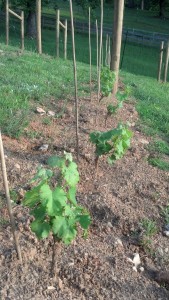
By the way, the un-hilling I did two weeks ago involved a lot of careful work with my hands, but it was positively crude compared to Chris’s method. I pushed the dirt aside a little bit at a time, until the vine was completely uncovered. Okay, maybe a spare bud or two got knocked off in the process.
Chris would have none of that. She bought a makeup brush for the final removal of soil from the vines, and claims it worked like a charm. I wasn’t there, so I’ll take her word for it. It seems like a pretty time-consuming approach, so I’m pretty confident that I’ll do my part of the un-hilling next year sans the makeup brush. Unless of course the vines she un-hilled do better than mine. Let’s not even go there, okay?
And there’s still so much work to be done. I think I’m recovering well enough from surgery that I’ll be able to be in Afton myself for the next trip. Chris and Kate have gotten to be quite the dedicated and skilled vineyard workers, handling everything from driving posts into the ground to planting vines. I’d sure like to be able to lend a hand. Or at least be there to watch with great enthusiasm while they do the work
The Great Experiment — Transplanting Cab Franc
Another busy weekend in the vineyard. We transplanted four Cab Franc vines from Fairfax, researched and ordered a deer fence, and installed the bottom, or fruiting wire on our trellises in Afton. And, of course, we spent some time admiring the fruit of our labors from the previous few weeks – 150 new vines buried under mounds of dirt. The reds, which
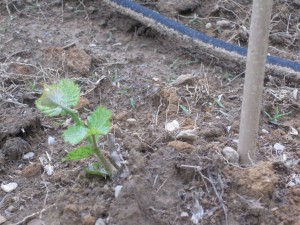
Three weeks after planting, the Viognier, pictured here, and the Petit Manseng, are emerging from the mounds of dirt that protected them from the spring frosts.
we planted two weekends ago, were still hidden away, but the whites we planted a week earlier – the Petit Manseng and the Viognier – were poking through the hills, and we were just thrilled to see them pushing through the earth! I have to say, they emerged from the mounds at just the right time, avoiding the frost that killed off our two prize Mammolo Toscano vines the previous weekend. Frost is an issue that we’ve been giving a lot of thought to after our experience this winter, and it influenced our decision on where to locate the fruiting wire. More on that in a future post.
For today, I’ll simply focus on our grand experiment, the transplanting of four of our Cab Franc vines from Fairfax to the Afton vineyard. We had planted a total of seven Cab Francs in Fairfax to get a bit of hands on experience close to home. I suppose at the back of my mind I thought I might eventually make a little wine from those vines, but mostly I
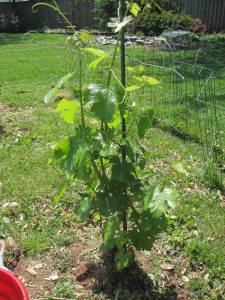
The Fairfax vines looked magnificent this Spring -- if a bit unruly. They need to be pruned, but that, I decided, would wait until they reached their new home.
wanted the experience of being able to go out in the evening after work to care for them and learn from that effort. We planted another five of the same clone and rootstock in Afton to see how the same vines would do in a different environment.
The Fairfax vines grew fast and they looked just beautiful. Clearly, the soil in Fairfax is rich, lending itself to high vigor growth. That’s good and bad, but probably mostly bad. It’s great to see the vines shoot up quickly, but ideally, we’d like them to struggle a bit so that the energy of the plant goes toward the grapes, not the vine itself. Left to its own, the vine will grow as high as it can find support – up a tree, for example, pushing toward the sunlight – but spectacular as that vine might be, Continue Reading–>
An Hour of Frost
Well, it doesn’t take much. The forecast called for temperatures in my part of Fairfax County to dip below freezing for less than two hours, but that was enough to do some damage. At least one of the vines appears to have sailed through the night with flying colors, but the others experienced at least some degree of frost damage. As noted in my
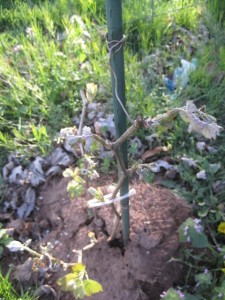
- Some damage on this vine – it’s hard to see in this picture, but compare the shriveled leaves on the right with the green, healthy ones on the left side.
previous post, this is a critical time of the year for vines. Late frost is a threat in any year, but the early bud break this spring left vines everywhere in the state exposed to the threat of frost in the weeks ahead.
As WineMaker magazine noted, late frost is a danger “because the first green growth produced on a new grapevine shoot is two or three basal leaves, immediately followed by the embryonic flower clusters that will become this year’s crop. So, if frost strikes, it can greatly reduce or even wipe out the whole vintage.”
For my vines in Fairfax, I believe the danger is even more acute because they are still small and the buds are so close to the ground, where the temperature is coldest. We’re still new at this, and it’s possible we pruned them back too far over the winter. For the vines we plant this spring, we’ll definitely be focused on strategies for dealing with late frost, and I’ll talk about some of them in an upcoming post.
Of course, one of the most important considerations in dealing with frost is site selection, and we’ve already cast that particular die. The Fairfax vineyard is challenged on at least two counts. It’s at a low elevation, and it’s on flat ground, so the cold air has no place to go. In Nelson County, where we have some vines planted and are preparing to plant another 150, the elevation is higher, around 750 feet, but not high enough to put us in the atmospheric sweet spot that probably runs from about 800 to 1,600 feet above sea level. On the other hand, the land is sloped, so the heavier cold air should flow down hill and off the vineyard. We’ll see.
But no matter how well you plan, you may still find yourself dealing with late frost. I suspect most commercial vineyards in the state were monitoring the vines throughout the night and taking steps to mitigate the frost threat. Larger vineyards have a number of tools they can bring to bear, including wind machines, heaters, and helicopters. Many vineyards gather the wood pruned from the vines over the winter and leave it at the end of the rows to burn on nights where frost threatens.
This year, we didn’t have a lot of choices beyond praying and hoping. However, the Fairfax vineyard is only experimental; I’m not expecting to ever make wine from those grapes, although it would be a definite bonus if I do. But for the vines we are putting in the ground this Spring, we’ll probably have some sleepless spring nights in our future.
Dormant Winter Pruning — and other Vineyard Considerations
After a long winter that sometimes seemed like it would never end, spring planting is just around the corner. And despite all the time we had to prepare for the new season, we are now feeling not quite as ready as we’d like to be.
We’ve ordered 150 vines –50 Petit Verdot, 50 Cab Franc, 25 Viognier and 25 Petit Manseng – and lately I’ve been waking up in the middle of the night wondering if we’ll have everything in place in time to plant. I’m still worried, but we’ve made enough progress lately, especially this weekend, that I’m feeling a bit better about the whole enterprise.
Our biggest concern is the trellis. If you’ve followed our progress through this blog, you’ll note that I didn’t worry about that last Spring when we planted 14 vines, split between our Fairfax and Nelson county properties, but that was different on a couple of counts. First, those vines were more for our education than for the eventual production of wine. And we’ve learned a lot from taking care of those vines. Wine in two years would be a bonus, but it wasn’t the goal when we planted them. The second reason I didn’t obsess over the trellis is that I didn’t expect those vines to reach the height of the first wire in that initial year. And since there are so few Continue Reading–>
Five Vintages of Cab Franc at Gadino Cellars
As I’ve said before, I believe that Cabernet Franc is Virginia’s signature red grape, even if Petit Verdot iscoming on strong. It is more cold-hardy than Merlot or Cabernet Sauvignon, and it ripens earlier. That’s important in Virginia, which can be prone to early frost, Fall rains, and the occasional harsh winter. And Cab Franc is a wonderful grape on its own. It has softer tannins than Cab Sauv, and while it might not be quite as age-worthy, wines today are being made (and
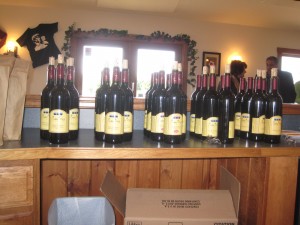
- Five Vintages of Cab Franc waiting to be poured, along with a mystery wine, hidden in brown bags for blind tasting
purchased) for early drinking, not for years in the cellar. Cab Franc will age, of course, but it is also more accessible when young than the more tannic reds. And Cab Franc can be used on its own or as a blend to make wines with great complexity, as the great St. Emilion blend, Cheval Blanc, demonstrates.
Cab Frank is particularly important to my wife, the Vineyard Goddess, and me, because it’s one of three grapes we will be planting this Spring, the other two being Petit Verdot and Viognier. (We had hoped to plant Petit Manseng as well, but couldn’t find the certified vines we wanted.)
So, I was thrilled to have the opportunity Saturday to participate in a vertical tasting of Cab Francs at Gadino Cellars in Washington, VA (Rappahannock County). We tasted wines from 2005, 2006, 2007, 2008, and 2009, plus a barrel sample of the 2011. The Gadinos threw in a mystery wine, which we tasted blind. More on the mystery wine later. Continue Reading–>

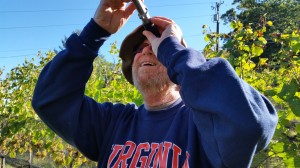
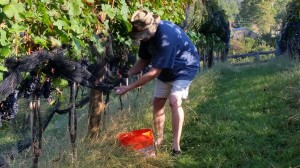
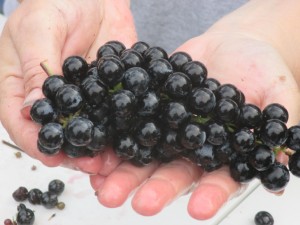
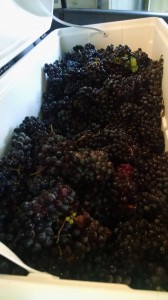
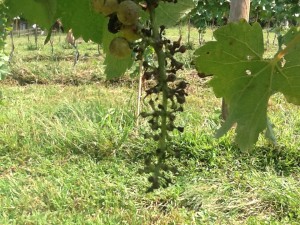
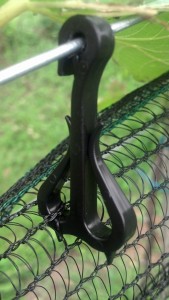
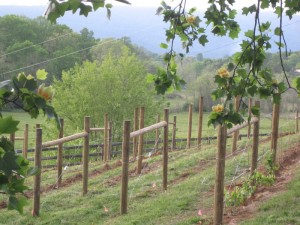
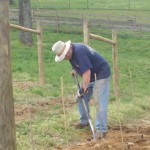
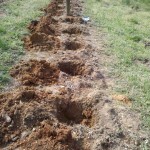
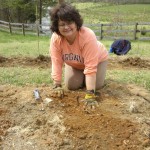
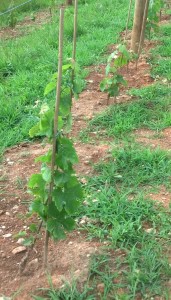

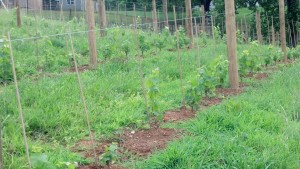
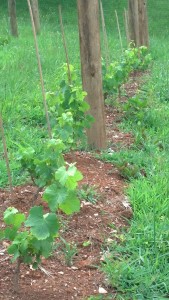
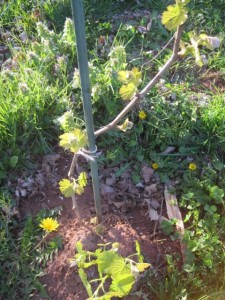
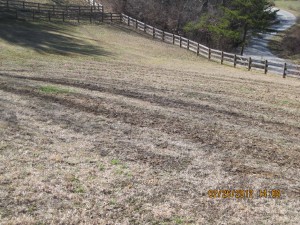
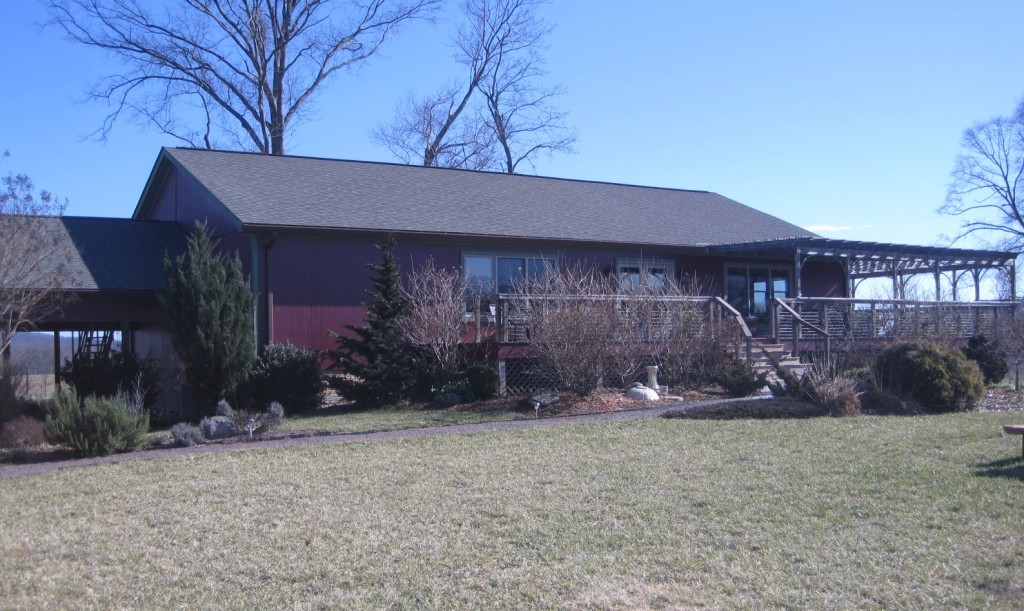


Recent Comments